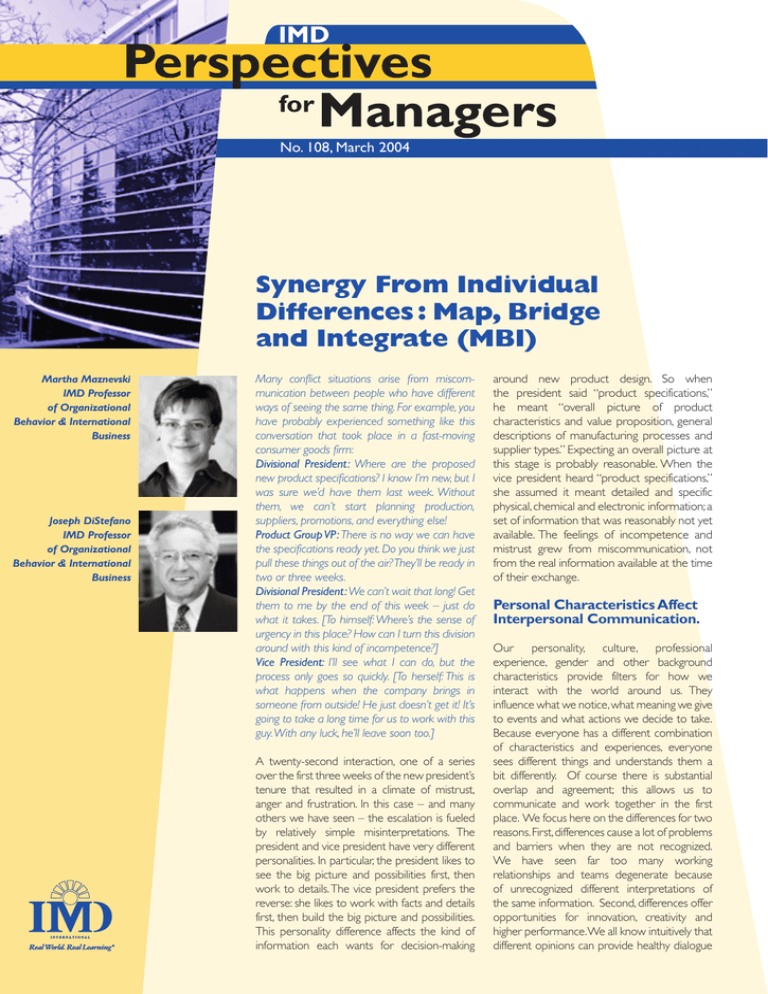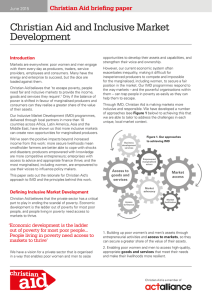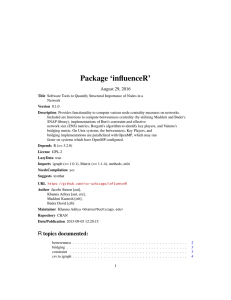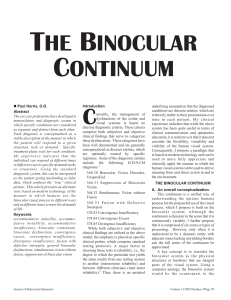108 _Masnevski_DiStefano.qxd
Anuncio

No. 108, March 2004 Synergy From Individual Differences : Map, Bridge and Integrate (MBI) Martha Maznevski IMD Professor of Organizational Behavior & International Business Joseph DiStefano IMD Professor of Organizational Behavior & International Business Many conflict situations arise from miscommunication between people who have different ways of seeing the same thing. For example, you have probably experienced something like this conversation that took place in a fast-moving consumer goods firm: Divisional President: Where are the proposed new product specifications? I know I’m new, but I was sure we’d have them last week. Without them, we can’t start planning production, suppliers, promotions, and everything else! Product Group VP: There is no way we can have the specifications ready yet. Do you think we just pull these things out of the air? They’ll be ready in two or three weeks. Divisional President:We can’t wait that long! Get them to me by the end of this week – just do what it takes. [To himself: Where’s the sense of urgency in this place? How can I turn this division around with this kind of incompetence?] Vice President: I’ll see what I can do, but the process only goes so quickly. [To herself: This is what happens when the company brings in someone from outside! He just doesn’t get it! It’s going to take a long time for us to work with this guy.With any luck, he’ll leave soon too.] A twenty-second interaction, one of a series over the first three weeks of the new president’s tenure that resulted in a climate of mistrust, anger and frustration. In this case – and many others we have seen – the escalation is fueled by relatively simple misinterpretations. The president and vice president have very different personalities. In particular, the president likes to see the big picture and possibilities first, then work to details. The vice president prefers the reverse: she likes to work with facts and details first, then build the big picture and possibilities. This personality difference affects the kind of information each wants for decision-making around new product design. So when the president said “product specifications,” he meant “overall picture of product characteristics and value proposition, general descriptions of manufacturing processes and supplier types.” Expecting an overall picture at this stage is probably reasonable. When the vice president heard “product specifications,” she assumed it meant detailed and specific physical, chemical and electronic information; a set of information that was reasonably not yet available. The feelings of incompetence and mistrust grew from miscommunication, not from the real information available at the time of their exchange. Personal Characteristics Affect Interpersonal Communication. Our personality, culture, professional experience, gender and other background characteristics provide filters for how we interact with the world around us. They influence what we notice, what meaning we give to events and what actions we decide to take. Because everyone has a different combination of characteristics and experiences, everyone sees different things and understands them a bit differently. Of course there is substantial overlap and agreement; this allows us to communicate and work together in the first place. We focus here on the differences for two reasons.First,differences cause a lot of problems and barriers when they are not recognized. We have seen far too many working relationships and teams degenerate because of unrecognized different interpretations of the same information. Second, differences offer opportunities for innovation, creativity and higher performance.We all know intuitively that different opinions can provide healthy dialogue Synergy From Individual Differences: Map, Bridge and Integrate (MBI) and, ideally, a synergy that is better than any single point of view. But achieving this synergy requires recognizing and working with differences in the first place. We have worked with hundreds of people and teams to prevent the problems and to achieve the potential that the differences offer. We have found that following three basic principles of interaction leads to success: Map, Bridge and Integrate. Map: Understand the Differences. Mapping is recognizing that differences exist and may be important, describing the differences with an objective framework, using this map to explain different perspectives, and then acting on the explanations to better deal with the work challenges. A good geographic map – such as a map of the Alps – satisfies three criteria. It shows the important features of the terrain; helps the map reader locate himself and other destinations; and it provides some guidance for getting from Point A to Point B. To create a good map, a cartographer uses objective data and updates the map with new information whenever necessary. 1 More information available from A good map of personal backgrounds has exactly the same features. It is a framework that identifies the important dimensions of differences between people: those that play a role in working together and decision-making. It helps each person describe his or her own characteristics in objective ways and compare them with those of other people, identifying the extent of similarities and differences. Finally, it provides information to help people explain and interpret various events by bridging distances. Good interpersonal maps are built using objective data, and continually revised with new information. Oxford Psychologist’s Press, www.opt.co.uk 2 More information available in J. DiStefano and M. Maznevski, “Culture in International Management: Mapping the Impact,” IMD Perspectives for Managers, 104, November 2003 2 People and their background characteristics can be plotted in different ways. Depending on the situation, it may be important to map characteristics of personality, function or profession, national or organizational culture, gender, or other dimensions. As a general guideline, we find that two maps cover most work situations and provide an important starting point for achieving synergy from differences: 1) cognitive preferences (for example, as measured by the Myers-Briggs Type Indicator, MBTI®)1, and 2) cultural assumptions (for example, as measured by the Cultural Perspectives Questionnaire, CPQ)2. A cognitive preferences map highlights individuals’ preferences for information processing, working, and learning styles, while a map of cultural assumptions focuses on individuals’ expectations about how others will interact, share responsibility, and work together. Bridge: Communicate Across Differences. Bridging increases effective communication by paying particular attention to interacting across differences. Bridge-building uses three sets of communication skills: Preparing a Foundation, Decentering and Recentering. Preparing a Foundation. Attitude may not be everything, but it certainly counts for a lot. Attitudes are internal states, and we can control them. With the right attitude from the beginning, we create the kind of environment that fosters effective communication. In bridging, two attitudes prepare the foundation. First, the people involved must be motivated to understand each other.They have to want to listen to what the other person says, from his or her own point of view. Second, they must be confident that, by working together, mutual understanding can be achieved. In the case described above, neither party was interested in understanding the other side – both wanted to persuade the other of their own point of view. Nor did either show confidence that they would eventually understand the other. Communication was difficult from the beginning. Decentering is moving away from your own “center”: thinking and communicating from the other person’s point of view. Decentering requires two skills: perspective-taking and blame-free explaining. Perspective-taking is seeing things from the other’s view and acting on that view. It is grounded on good mapping. For example, once the president knew that the vice president looked at details first, he became more specific in his requests to her. Recentering is moving both parties – or a whole team – to a center they identify together. While decentering focuses on differences, recentering builds on similarities. Good recentering means developing a common view and common rules of interaction. To develop a common view, everyone maps the situation and their perspectives to identify areas of overlap. For example, both the president and vice president want the new product to satisfy the right consumer needs. Although this seems obvious, when the people involved have different perspectives, it is important to say it explicitly and describe it carefully. Usually people assume they have a common view but really don’t (e.g. the meaning of “product specifications” or “sharing decisions”). Good decentering often produces the type of discussion that identifies the real common view, providing a foundation for innovation and synergy. Common rules are agreements on how to interact together. People go into meetings and conversations with expectations about behavior like interruptions, conflict and progress towards decisions. The agreements for common norms can be about what to do, such as always start a meeting with an agenda, or about what not to do, such as trying to be funny by ridiculing someone. When people have different expectations about these behaviors, they often misinterpret each other’s actions. To communicate effectively across differences, people in a discussion or team must identify these different expectations and then agree on some common behaviors and their meanings. Usually they choose a combination of each party’s norms.The most skilled communicators agree explicitly that different people can operate using different communication behaviors, with common agreement about what those behaviors mean. Such insightful bridging depends on accurate mapping – of oneself as well as the other person – and the courage to be open. Integrate – Build on Differences for Synergy. Integrating is the last step in getting high performance from interpersonal differences. The skills needed here are much the same as they are in any team situation, but they lead to better quality decisions and implementation when they are built on strong mapping and bridging. The three integrating skills are managing participation, resolving conflicts, and building on ideas. Managing participation is clearly the first step to creating and implementing new ideas. It is impossible to build high quality solutions unless you have everyone’s input – their best ideas – to start with.And people contribute their best ideas in a setting that fits their personality and expectations. The key here is to engage in different modes of participation across a decision-making task: in small groups, large groups, and one-to-one; in writing, with pictures and through spoken dialogue, both in-person and electronically. This way, people can provide their best input in a comfortable manner and respond to others on their own terms.The leader should play an active role in balancing the different modes, ensuring that everyone is contributing and responding. The next challenge is to resolve conflicts constructively. When two people or a group are reaching for synergy,they will face significant disagreement: “Okay, I understand your perspective, but I still don’t agree.” One oftenforgotten step is detecting disagreement in the first place. Different people and cultures express conflict differently and these signals are often misread.The parties should make extra efforts to deal with the conflict in appropriate ways – as relevant disagreement among people who respect and understand each other, and not as a battle for right and wrong. www.imd.ch Blame-free explaining kicks in when a problem occurs. Poor communicators tend to blame the other party, attributing negative characteristics or simply dismissing the other view (“He doesn’t know what he’s doing,”“She is incompetent.”). Good bridgers assume that the problem arose from differences in starting points or perspectives. They withhold blame and negative judgment, and explore the nature of the different perspectives. The president could have said “Why don’t you show me what you’ve got already?”, the vice president could have said “What kind of information would you like at this point? Here’s what I can give you as a start.”This blame-free explaining, combined with perspective-taking and good mapping, usually leads to insights and new ways of seeing the situation. 3 Synergy From Individual Differences: Map, Bridge and Integrate (MBI) Mapping and bridging provide exactly the tools needed for good conflict resolution. Mapping the different perspectives provides an objective picture of how far apart the parties are,lowering defenses and setting the stage to develop ideas for how to create new solutions. Bridging brings positive attitudes and behaviors that create winwin solutions. And if participation is managed well, all parties will contribute to the solution and are likely to buy into it and implement it well. Building on ideas is going beyond resolving differences to create new solutions for problems and challenges. This is when leaders and their subordinates reach new levels of innovation in revenue, cost and organizational systems. It is how key account teams develop systems that compel customers, and how logistics and operations teams find real synergies across value chains, far beyond the cost cutting that comes from eliminating redundancies.To build on ideas, use all the techniques you’ve experienced, heard about and read about, including brainstorming and creative exercises. At first, focus on exploring differences rather than similarities, building on each other’s ideas, and trying to invent new ideas.Then, using conflict resolution skills, do more than combine and compromise. Find new solutions that excite everyone. In the opening case, after mapping and bridging their differences, the president and vice president worked together to develop the new product and the systems to support it. They went through successive iterations of looking at the overall picture and how the product would meet various needs, and details of components and suppliers.After some tough discussions,they created some new features that customers hadn’t originally asked for, but that met other needs the distributors had. And, through careful examination of the supplier and manufacturing side, they were able to decrease costs and increase production efficiency. The launch was later than the company had hoped, but the product did very well and became the anchor of a new line.Along the way, the president and vice president learned to incorporate the interaction skills into other projects they were working on, which also benefited from the process. Summary. The most frequent response to differences is to downplay them:“Our differences are minor and 4 unimportant, let’s focus on the areas we have in common.” People know that focusing only on differences usually leads to a negative spiral of blame and distrust. However, focusing only on commonalities just gets to the lowest common denominator. It provides mediocre results, not high performance. The Map-Bridge-Integrate process uses an objective assessment of differences and similarities as input for an ongoing dialogue. In this dialogue, original areas of commonality serve as the foundation for discussing differences, and new areas of commonality are built. Mapping, bridging and integrating must work together. Performance comes from integrating, but integrating cannot happen without bridging. In fact, according to our research, good bridging almost always leads to good integrating. If you get bridging right, you’ll almost certainly get integrating and the accompanying performance. Bridging, in turn, rests on good mapping. Maps provide the objective input for building bridges; both the attitudes and the skills. The MBI process cannot be put in place with policies. It is a set of skills that must be practiced and learned over time. The good news is that even a little bit of MBI brings an improvement in performance and people tend to see quick results in their interactions. In today’s economic environment, every leader needs to accomplish more with the human resources he or she has. Map-Bridge-Integrate is a good set of practices to achieve that goal. IMD P. O. Box 915, CH-1001 Lausanne, Switzerland Tel.: +41 21 618 0342 Fax: +41 21 618 0715 [email protected] http://www.imd.ch Editor: Roger Whittle © IMD, March 2004. No part of this publication may be reproduced without written authorization.






